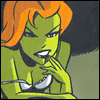|
corkskroo posted:like a billion photos In a controlled setting it looks like you aren't having too much trouble with exposure, but you really need to work on your framing and the emphasis that you put on different elements of your subject matter. Anybody can get a light to work in their favour if they mess with it for long enough, but the thing that separates the big guns from the amateurs is the ability to unify a shot so that everything looks like it belongs together. Your first shot doesn't make any sense- there's some girl walking through the background, and then there's some spindly things, huge blowouts of overexposure and no emphasis placed on the food whatsoever. In your shot of the west african food, I can't tell if the thing in the bowl is a ball of rice or a ball of dough. Your best shot is the second from the bottom- it's the most cohesive and as a viewer I can understand everything that is going on in the picture. That's good. Something that might help you is dominance. It's kind of like the rule of thirds, but taken to the next step. A cheat to making a good photograph is to ensure that you have three major components: a dominant object, a sub-dominant element, and a subordinate element. The dominant object is the one with the greatest amount of weight in the picture. It's what you can put in the foreground, make the largest, keep in best focus. It doesn't always have to be kept 100% in frame, because your sub-dominant and subordinate elements can be used to give this object context. This is the way you can make soup look exciting. The sub-dominant object is what you place in the middle-ground of the picture. It can be a little bit blurry, or completely in focus. But it mustn't take as much precedence in the photo as the dominant object. It should be like the pilot fish to the shark. It can help create perspective, and tell part of the story. If you are photographing split pea soup, your sub-dominant element might be a spoon, or a folded napkin. The subordinate element is the littlest helper. It can be an object in the background that is blurred out with creative DoF, or it can be something more spatial, like a wooden tabletop. The accident that I see you making over and over is that you are trying to place too many sub-dominant or subordinate elements in your compositions. In your tuna spoons, your dominant element is pretty clear, but the plates in the top left corner and the additional spoons all have the same visual weight (brightness and overexposure) and that creates unnecessary complexity. The first shot of egg salad sandwiches has two sub-dominant elements as well, the bottle and the glass. It's too much to look at, and detracts from the importance of the sandwiches. I attached a picture to help, it's not my photo (taken from Sunday Suppers, a really good blog) but it's a drat fine illustration of dominant/sub-dominant/subordinate elements that tell a really nice story.
|
|
|
|

|
| # ¿ May 5, 2024 19:06 |



